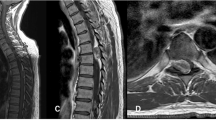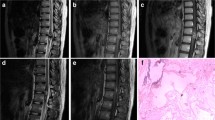Abstract
Background
Pure spinal epidural cavernous malformation (CM) is a rare hypervascular disease that is easily misinterpreted as other imaging-similar epidural lesions. The demographic characteristics, therapeutic strategies, and surgical outcomes associated with this vascular entity remains unclear.
Methods
A retrospective review of patients with pathologically proven, pure epidural CM from 2001 to 2018 was conducted. All data that included clinical manifestations, radiographic features, and treatment modalities were analyzed.
Results
Twenty-three consecutive patients with an average age of 51.5 ± 8.4 years old (range 38–70 years old) were included; of these, 52.2% were female patients. Clinical manifestation included chronic progressive nerve root disturbance syndrome in 7 patients (30.4%) and myelopathy in 16 patients (69.6%). The CM level was predominately thoracic (n = 14, 60.9%) or lumbar (n = 6, 26.1%), with the dorsal epidural space (n = 14, 60.9%) the most common site. The initial clinical diagnoses were schwannoma (n = 11, 52.2%), meningioma (n = 5, 21.7%), angioma (n = 3, 13.1%), recurrent CMs (n = 2, 8.7%), and metastatic tumor (n = 1, 4.3%). Fifteen lesions (65.2%) were isointense on T1-weighted images, and all lesions were hyperintense on T2-weighted images, with homogenously strong enhancement observed in 17 lesions (73.9%). Total resection was achieved in 18 patients (78.3%) and usually resulted in excellent clinical outcomes (n = 21, 91.3%). No patients experienced recurrence of symptoms, and lesion relapse during follow-up.
Conclusion
Total surgical removal of epidural CM can usually achieve satisfactory outcomes in patients with a chronic clinical course and should be recommended. Subtotal removal of tumors can also benefit patients, and guaranteed a long recurrent free time after surgery. A good preoperative neurological condition usually leads to good outcomes.


Similar content being viewed by others
References
Aoyagi N, Kojima K, Kasai H (2003) Review of spinal epidural cavernous hemangioma. Neurol Med Chir (Tokyo) 43(10):471–475 discussion 476
Appiah GA, Knuckey NW, Robbins PD (2001) Extradural spinal cavernous haemangioma: case report and review of the literature. J Clin Neurosci 8(2):176–179
Bayri Y, Eksi MS, Yalcinkaya Koc D, Konya D (2015) Spinal epidural cavernous angioma: two case reports and review of the literature. Acta Orthop Traumatol Turc 49(4):459–464
Carlier R, Engerand S, Lamer S et al (2000) Foraminal epidural extra osseous cavernous hemangioma of the cervical spine: a case report. Spine (Phila Pa 1976) 25(5):629–631
Caruso G, Galarza M, Borghesi I et al (2007) Acute presentation of spinal epidural cavernous angiomas: case report. Neurosurgery 60(3):E575–E576 discussion E576
Cossandi C, Fanti A, Gerosa A et al (2018) Rare case of dumbbell-shaped spinal cavernous Hemangioma and literature review. World Neurosurg 120:181–184
D'Andrea G, D'Andrea G, Ramundo OE, Trillo G et al (2003) Dorsal foramenal extraosseous epidural cavernous hemangioma. Neurosurg Rev 26(4):292–296
Daneyemez M, Sirin S, Duz B (2000) Spinal epidural cavernous angioma: case report. Minim Invasive Neurosurg 43(3):159–162
Esene IN, Ashour AM, Marvin E et al (2016) Pure spinal epidural cavernous hemangioma: a case series of seven cases. J Craniovertebr Junction Spine 7(3):176–183
Frankel HL, Hancock DO, Hyslop G et al (1969) The value of postural reduction in the initial management of closed injuries of the spine with paraplegia and tetraplegia. I Paraplegia 7(3):179–192
Gencpinar P, Acikbas SC, Nur BG et al (2014) Epidural capillary hemangioma: a review of the literature. Clin Neurol Neurosurg 126:99–102
Goyal A, Singh AK, Gupta V, Tatke M (2002) Spinal epidural cavernous haemangioma: a case report and review of literature. Spinal Cord 40(4):200–202
Hakan T, Demir M, Aker F, Berkman M (2007) Pregnancy-related spinal epidural capillary-cavernous haemangioma: magnetic resonance imaging and differential diagnosis. Australas Radiol 51 Spec No:B6–B9
Hatiboglu MA, Iplikcioglu AC, Ozcan D (2006) Epidural spinal cavernous hemangioma. Neurol Med Chir (Tokyo) 46(9):455–458
Huang KT, McAvoy M, Helgager J et al (2018) Spinal hemangioma mimicking a dumbbell-shaped schwannoma: case report and review of the literature. J Clin Neurosci 50:160–162
Jeong WJ, Choi I, Seong HY, Roh SW (2015) Thoracic extradural cavernous hemangioma mimicking a dumbbell-shaped tumor. J Korean Neurosurg Soc 58(1):72–75
Khalatbari MR, Abbassioun K, Amirjmshidi A (2013) Solitary spinal epidural cavernous angioma: report of nine surgically treated cases and review of the literature. Eur Spine J 22(3):542–547
Khalatbari MR, Hamidi M, Moharamzad Y (2013) Acute presentation of solitary spinal epidural cavernous angioma in a child. J Coll Physicians Surg Pak 23(5):364–366
Kim KH, Song SW, Lee SE, Lee SH (2012) Spinal epidural arteriovenous hemangioma mimicking lumbar disc herniation. J Korean Neurosurg Soc 52(4):407–409
Kivelev J, Niemela M, Hernesniemi J (2010) Outcome after microsurgery in 14 patients with spinal cavernomas and review of the literature. J Neurosurg Spine 13(4):524–534
Lee JW, Cho EY, Hong SH et al (2007) Spinal epidural hemangiomas: various types of MR imaging features with histopathologic correlation. AJNR Am J Neuroradiol 28(7):1242–1248
Li TY, Xu YL, Yang J et al (2015) Primary spinal epidural cavernous hemangioma: clinical features and surgical outcome in 14 cases. J Neurosurg Spine 22(1):39–46
McCormick PC, Michelsen WJ, Post KD et al (1988) Cavernous malformations of the spinal cord. Neurosurgery 23(4):459–463
Muhmer M, Bostelmann R, Sarikaya-Seiwert S et al (2014) Clinical and radiological presentation of spinal epidural haemangiomas: clinical series in a tertiary care centre during a 10-year period. Eur Spine J 23(2):404–410
Nagi S, Megdiche H, Bouzaidi K et al (2004) Imaging features of spinal epidural cavernous malformations. J Neuroradiol 31(3):208–213
Pojskic M, Zbytek B, Mutrie CJ, Arnautovic KI (2018) Spinal dumbbell epidural hemangioma: two stage/same sitting/same position posterior microsurgical and transthoracic endoscopic resection - case report and review of the literature. Acta Clin Croat 57(4):797–808
Rigamonti D, Johnson PC, Spetzler RF et al (1991) Cavernous malformations and capillary telangiectasia: a spectrum within a single pathological entity. Neurosurgery 28(1):60–64
Sarikaya-Seiwert S, Gierga K, Wessalowski R et al (2010) Solitary spinal epidural cavernous angiomas in children presenting with acute neurological symptoms caused by hemorrhage. J Neurosurg Pediatr 5(1):89–93
Shin JH, Lee HK, Rhim SC et al (2001) Spinal epidural cavernous hemangioma: MR findings. J Comput Assist Tomogr 25(2):257–261
Simard JM, Garcia-Bengochea F, Ballinger WE et al (1986) Cavernous angioma: a review of 126 collected and 12 new clinical cases. Neurosurgery 18(2):162–172
Sohn MJ, Lee DJ, Jeon SR, Khang SK (2009) Spinal radiosurgical treatment for thoracic epidural cavernous hemangioma presenting as radiculomyelopathy: technical case report. Neurosurgery 64(6):E1202–E1203 discussion E1203
Yunoki M, Suzuki K, Uneda A, Yoshino K (2015) A case of dumbbell-shaped epidural cavernous angioma in the lumbar spine. Surg Neurol Int 6(Suppl 10):S309–S312
Zevgaridis D, Medele RJ, Hamburger C et al (1999) Cavernous haemangiomas of the spinal cord. A review of 117 cases. Acta Neurochir 141(3):237–245
Zhong W, Huang S, Chen H et al (2012) Pure spinal epidural cavernous hemangioma. Acta Neurochir 154(4):739–745
Acknowledgments
Hospitals in the article refer to the Chinese PLA General Hospital.
Author information
Authors and Affiliations
Corresponding author
Ethics declarations
Conflicts of interest disclosure
The authors declare that they have no conflict of interest.
Ethical approval
All procedures performed in studies involving human participants were in accordance with the ethical standards of the institutional and/or national research committee by the 1964 Helsinki Declaration and its later amendments or comparable ethical standards.
Informed consent
Informed consent was obtained from all individual participants included in the study.
Additional information
Publisher’s note
Springer Nature remains neutral with regard to jurisdictional claims in published maps and institutional affiliations.
This article is part of the Topical Collection on Tumor - Other
Rights and permissions
About this article
Cite this article
Zhang, L., Qiao, G., Shang, A. et al. Clinical features and long-term surgical outcomes of pure spinal epidural cavernous hemangioma—report of 23 cases. Acta Neurochir 162, 2915–2921 (2020). https://doi.org/10.1007/s00701-020-04358-x
Received:
Accepted:
Published:
Issue Date:
DOI: https://doi.org/10.1007/s00701-020-04358-x




